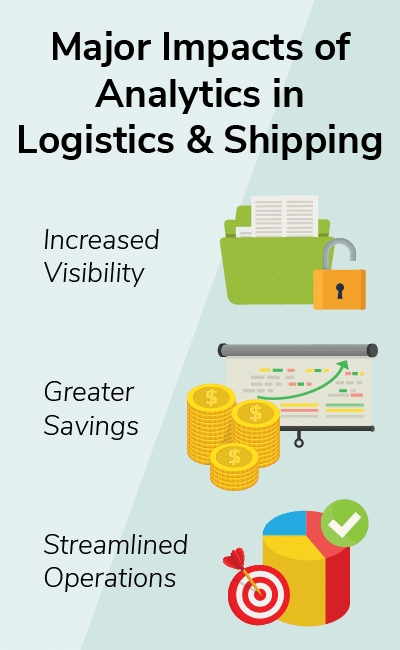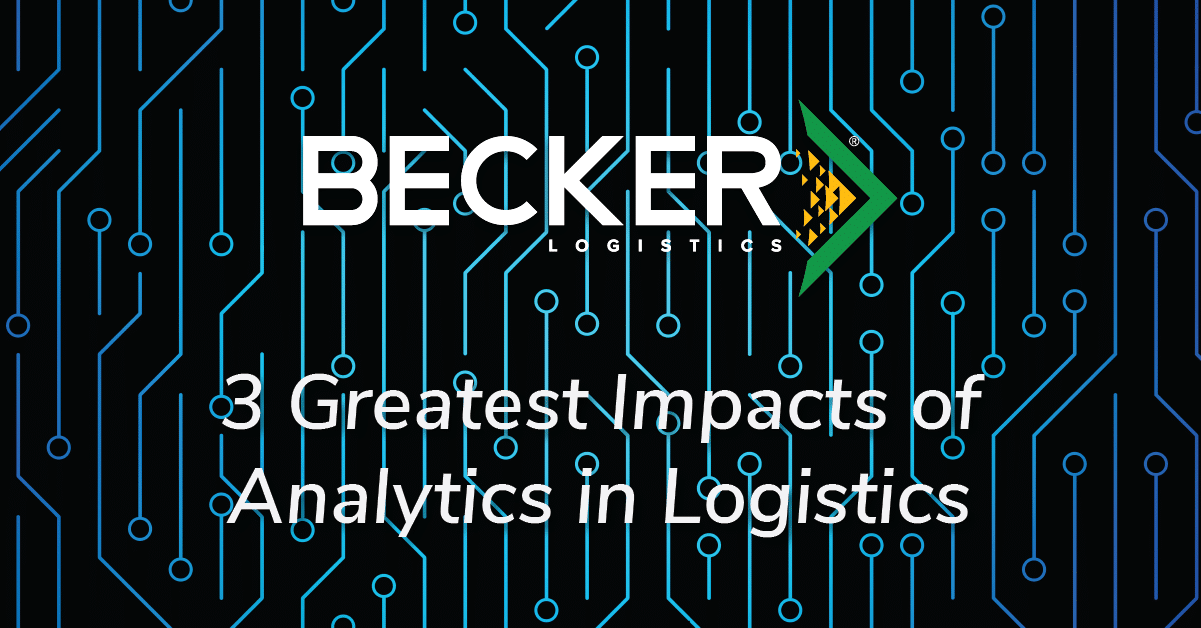Analytics in logistics is evolving and getting better every single day. Every company is in a never-ending race to get the “perfect” supply chain. Transportation and logistics analytics are used to achieve this goal.
With an increase of last-mile services, automation, and artificial intelligence data analytics has never been so important. In fact, it’s now at the point where using your data effectively is a prerequisite in order to succeed as ANY company.
Increased analytics in logistics leads to a greater supply chain through increased visibility, greater savings, and streamlined operations.
Impact of Analytics in Logistics
Increased Visibility
Visibility is always a good thing. You can never have too much insight into your transportation and logistics analytics. Many say that visibility should be priority number one and it makes sense. With visibility, you are able to make informed decisions that will improve your shipping. You are no longer just reacting to the cause of some effect; with visibility, you can be proactive and really take control.
Greater Savings
Greater savings is a priority for every company. No one want’s to be spending money just for the fun of it. If there is a way for a shipper to shave 5 or 10% off of their shipping then they are going to take it. Analytics in logistics helps save money by looking at where your money is going, how often you’re spending, and when you’re spending the most.

A recent example we had was a customer that had many pick-ups and drop-offs scheduled on the weekend. Well, most carriers don’t want to work on the weekend and are going to charge more money to do so. After uncovering this the shipper was able to respond. They offset as much as they could to the weekdays and saw significant savings.
This is a pretty simple example but highlights that data and analytics are absolutely needed to stay competitive in today’s landscape.
Streamlined Operations
Streamlined operations include route optimization, predictive analytics, and better order processes. Route optimization is something that is really taking off with the increased adaption of real-time track and tracing. Carriers can now be tracked in real-time which means that every second of the aspect of the journey can be monitored. Maybe it turns out that taking a detour to get to the other side of a major hub is more efficient than driving through. If so, then the information is sent and the driver makes faster deliveries.
Predictive analytics in logistics uses machine learning or A.I. to pull in A LOT of data. This data is used to detect any sort of anomaly or abnormality. These anomalies can tell us that certain events actually have an impact on things we would have never seen otherwise.
An example of predictive analytics would be discovering that certain lanes are slowed down during certain times of the year due to weather. Predictive analytics is all about finding connections in the data and using those connections to make predictions.
Order processes can be streamlined by finding the best way for the shipper to get all the needed information to the 3PL or carrier. This is usually done through EDI’s and API’s. However, analytics tells us how to best implement these tools.
Common Transportation and Logistics Analytics
Freight Spend and Volume
Freight spend and volume is pretty much a must-have. You have to be able to, at the very least, look at when you are shipping and how much you are spending. This report can tell you that certain times, days or weeks, cost more to ship. Additionally, it can show that shipping costs, in general, are rising/falling.
Lane Data
Lane data is another must-have for transportation and logistics analytics. With lane data, you can track the specifics of each route a carrier is taking. With this data, you are able to see which routes require more attention. Additionally, you can determine when you should go from spot to contract on certain lanes.
Time Statistics
Time is the most important asset in shipping and logistics. Knowing how much time is spent on shipping and ensuring KPIs are hit is vital. This kind of data is used to make sure that freight is being picked up and delivered on time consistently. Also, it is used to make sure that there are no massive changes in time to ship your freight.
Partnering With A 3PL to Get Your Analytics in Logistics
We have now covered the importance and impact of analytics in logistics as well as some examples. It should be apparent that this type of data and visibility is important to all shippers. However, how do they go about getting this data for themselves?

Without investing in a bunch of technology, hiring, and training partnering with a 3PL is going to be the best option. 3PL’s already have the tools set up and their teams trained to pull and analyze this data. 3PL’s know the importance of transportation and logistics analytics and make sure that it is available to all of their customers either as requested or in regular meetings.
At Becker Logistics we are dedicated to providing the best shipping experience to all of our customers which is why we always focus on the data. We use a top-of-the-line TMS, track and trace, and other powerful data tools to make sure nothing gets overlooked. If you want to see if Becker Logistics is the 3PL for you then reach out and contact us directly or request a quote and get started immediately.
